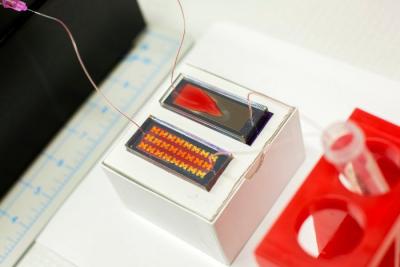The Graphene-Info Newsletter (October 2013)
Published: Tue, 10/01/13
Graphene based cancer treatment coming soon? |
Researchers from the University of Michigan developed a new microfluidic chip based on Graphene Oxide (GO) that can capture tumor cells from blood and support their growth for further analysis. This device could be used for both cancer diagnosis and find the best test-treatment options, without biopsies. The researchers estimate that such chips could reach clinics within 3 years.
The new chip developed at Michigan has a silicon base, and on top of it are almost 60,000 tiny gold shapes - each looking like a four-petaled flower. The researchers coated those gold flowers with GO, and this GO captures the cancer cells. It is possible to use this chip to capture pancreatic, breast and lung cancer cells from patient samples.
Graphene-based cancer treatment seems to be a hot topic. Earlier in September, Grafoid and ProScan Rx Pharma announced a new joint-venture partnership to develop MesoGraf graphene-based nanotechnology platform for the precise targeting and thermal eradication of solid cancer tumors. This new platform aims to overcome the side effects and strong limitations of common cancer therapies.
The two companies established a new company called Calevia. Grafoid invested in Calevia and will co-manage the company. Calevia will first target prostate cancer using ProScan’s anti-PSMA antibody and they will use a partially edge-functionalized MesoGraf derivative called MesoGraf Xide taht instantly transforms near infrared (NIR) light into heat.
The NSF grants $744K to fun Graphene Frontier's roll-to-roll production |
Graphene Frontiers has been awarded a $744,600 grant from the National Science Foundation (NSF) to develop roll-to-roll graphene production. This is a SBIR Phase II grant that will focus on scaling Graphene Frontier's production capacity.
Graphene Frontier's technology was developed at the University of Pennsylvania. It is called Atmospheric Pressure CVD, or APCVD. This roll-to-roll process does not need a vacuum so it works in room pressure. The equipment required is smaller, faster and cheaper compared to CVD and this means that the manufacturing will be cost effective.
Graphene Frontier's CEO discussed the company's technology and business on graphene-info, click here to read the full article.
Bluestone opens a European fab in Manchester |
Bluestone Global Tech decided to open a new European graphene production plant at the University of Manchester. Bluestone will also partner with the University on several projects. Those projects (detailed below) are estimated at £5 million ($7.8 million).
In the first stage, Bluestone will open a pre-production facility and will offer graphene material to the University's scientists. Later on BGT will setup a larger headquarters and a pilot production line at the NGI and will also work towards partnership with other consumer companies.
Bluestone will also participate in several projects, estimated at £5 million ($7.8 million). Those projects include the Plasmonic (rapid transmission of information using wires) research led by Professor Alexander Grigorenko, the Supercapacitors using graphene and other 2D materials research led by Professor Rob Dryfe and the Graphene oxide membranes research led by Dr Rahul Nair.
New Graphene-on-silicon photodetector research |
Two different teams of researchers released articles describing new advances in graphene-on-silicon based photodetectors. These devices hold promise because it could lead to more simple device fabrication - and those devices will be very fast compared to current photo detectors and be responsive to a wider range of light frequencies.
A team from MIT, Columbia University and IBM developed a new graphene-on-silicon photodetector in which light enters the detector through a silicon channel which acts like a waveguide. In their experiments, the unbiased (no applied voltage) detector generated 16 milliamps of current for each watt of incoming light and its detection frequency was 20 gigahertz. This is competitive with unbiased germanium based photodetectors. And with better engineering, their design could yield even better performance.
The second research team comes from TU Vienna and the Kepler University in Linz. They used a narrow waveguide in a similar design to the one from the US researchers. The second photodetector is extremely fast and is very compact - suitable for data communication. You could fit 20,000 such detectors in a single chip with a surface area of one square centimeter - so this tiny chip will be able to read 20,000 information channels at once.
Top Graphene News |
Intel reports great progress with graphene transistors
Intel's CEO says that researchers at Intel are seeing some great progress towards graphene based transistors, but it is still a a few generations away
DNA strands used to assemble graphene ribbons
Researchers from Stanford developed a new way to produce graphene ribbons (GNRs) using DNA strands, and used those GNRs to produce transistors.
Graphene can replace CNTs for better glucose sensors
NRL researchers report that graphene can replace carbon nanotubes in glucose sensors. The graphene improves the performance and designs of the sensors.
Graphene Platform and Nissha printing graphene-ink alliance
Graphene platform, Cambridge Graphene Platform (CGP) and Nissha Printing will co-develop new electronic devices based on CGP s graphene ink technology. This alliance is expected to last three years.
Graphene Oxide enables plant antibacterial agents
Researchers developed DNA-directed silver nanoparticles grown on graphene oxide and use them as effective plant antibacterial agents.
BCC Research: graphene product sales to reach $1.3 billion by 2023
BCC Research forecasts that the global graphene product market will reach $195 million 2018. This will grow quickly to $1.3 billion by 2023 (an annual compound annual growth rate of 47.1%).
Send this to a friend |
Do you have a friend or a colleague that might be interested in Graphene technology? Forward this mail to update him on the
world of Graphene.
If you received this email from a friend, subscribe to this
newsletter here!

